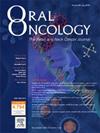涎腺癌的精准医疗:来自乳腺癌和前列腺癌的见解
IF 4
2区 医学
Q1 DENTISTRY, ORAL SURGERY & MEDICINE
引用次数: 0
摘要
唾液腺癌(SGC)是一种异质性的疾病,具有不同的组织学、生物学、临床行为和治疗方法。世界卫生组织将SGCs分为低攻击性和高攻击性两类。由于其罕见性和独特的生物学特性,管理SGCs具有挑战性,通常需要专家的组织学诊断和基于低水平证据的治疗。尽管最近有国际指南,但SGC管理的几个关键方面仍未解决,特别是关于系统治疗。最近发现的分子改变,如HER2扩增和AR过表达,为替代治疗提供了诊断、预后和预测性生物标志物。虽然一些靶向治疗有相应的ema批准的治疗方法,但其他治疗方法没有。同步改变(如ar阳性SGCs伴HER2扩增)使治疗策略进一步复杂化。对于这些药物的最佳使用,无论是在早期疾病、手术后还是在姑息治疗中,仍有悬而未决的问题。鉴于该疾病的罕见性和文献中缺乏高质量的数据,与其他更常见的疾病(如乳腺癌和前列腺癌)进行交叉受精是很重要的。在当前的叙述性回顾中,我们分析了唾液腺癌靶向治疗的现有证据及其与乳腺癌和前列腺癌的共同特征。本文章由计算机程序翻译,如有差异,请以英文原文为准。
Precision medicine in Salivary Gland Carcinoma: Insights from breast and prostate cancer
Salivary Gland Carcinomas (SGC) are a heterogeneous group of diseases with varied histologies, biology, clinical behaviors, and therapeutic approaches. The World Health Organization classifies SGCs into Low Aggression and High Aggression categories. Due to their rarity and unique biology, managing SGCs is challenging, often requiring expert histological diagnosis and treatment based on low-level evidence. Despite recent international guidelines, several critical aspects of SGC management remain unresolved, in particular regarding systemic treatment. Recent discoveries of molecular alterations, such as HER2 amplification, and AR overexpression, have provided diagnostic, prognostic, and predictive biomarkers for alternative treatments. While some targeted treatment have corresponding EMA-approved therapies, others do not. Treatment strategies are further complicated by synchronous alterations, such as AR-positive SGCs with concomitant HER2 amplification. Open questions remain on the optimal use of these drugs, whether in early-stage disease, post-surgery, or in palliative settings. Given the rarity of the disease and the consequent lack of high quality data in literature, it is of importance a cross-fertilization process from other, more common disease such as breast and prostate cancers. In the current narrative review we analyze current evidence on the targeted treatment on salivary gland carcinomas and shared features with breast and prostate cancer.
求助全文
通过发布文献求助,成功后即可免费获取论文全文。
去求助
来源期刊

Oral oncology
医学-牙科与口腔外科
CiteScore
8.70
自引率
10.40%
发文量
505
审稿时长
20 days
期刊介绍:
Oral Oncology is an international interdisciplinary journal which publishes high quality original research, clinical trials and review articles, editorials, and commentaries relating to the etiopathogenesis, epidemiology, prevention, clinical features, diagnosis, treatment and management of patients with neoplasms in the head and neck.
Oral Oncology is of interest to head and neck surgeons, radiation and medical oncologists, maxillo-facial surgeons, oto-rhino-laryngologists, plastic surgeons, pathologists, scientists, oral medical specialists, special care dentists, dental care professionals, general dental practitioners, public health physicians, palliative care physicians, nurses, radiologists, radiographers, dieticians, occupational therapists, speech and language therapists, nutritionists, clinical and health psychologists and counselors, professionals in end of life care, as well as others interested in these fields.
 求助内容:
求助内容: 应助结果提醒方式:
应助结果提醒方式:


